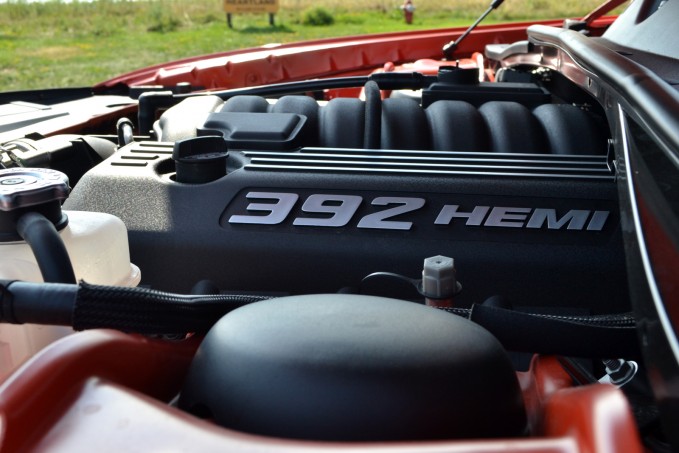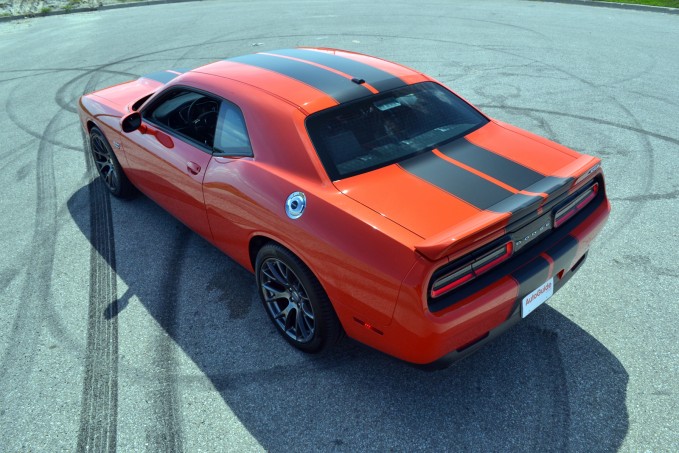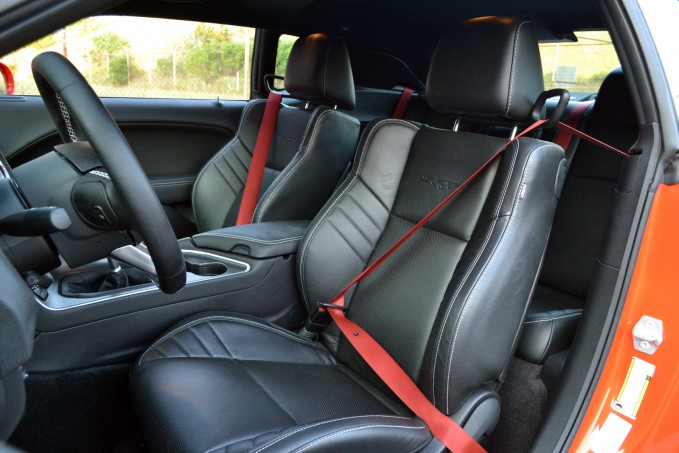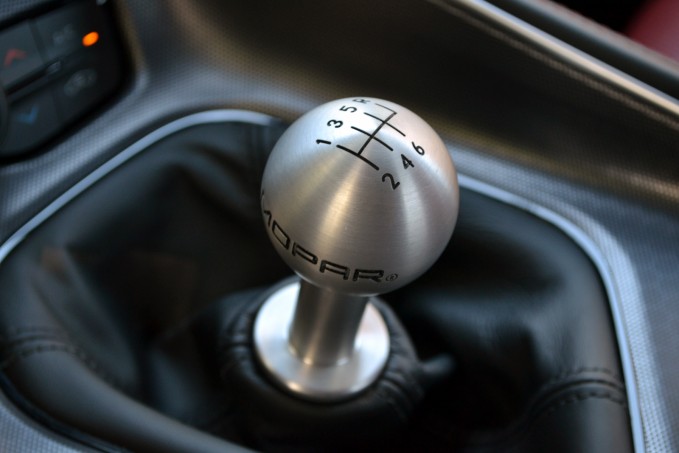You don’t have to opt for the hedonistic Hellcat to have fun in a Dodge Challenger.
Not that there’s anything wrong with having 707 horsepower and 650 lb-ft of torque underfoot, but all that muscle isn’t mandatory. It’s also a quick way to star in the next viral cars-and-coffee video for the wrong reasons, with that much power proving potentially dangerous in the wrong hands. That’s not to say the almost 500 horsepower in the Dodge Challenger SRT 392 is suddenly child’s play, but it’s far more approachable than the supercharged insanity of the Hellcat. It’s also still capable of a right-foot riot at a moment’s notice.
Almost as Hellacious
Putting aside the 707 reasons to love the Hellcat, there’s plenty about the other SRT-tuned Challenger to enjoy. It’s basically a Hellcat minus, well, the Hellcat, with a naturally aspirated 6.4-liter Hemi V8 in place of the supercharged 6.2-liter. Otherwise, there is very little separating the two cars’ componentry.
The suspension setup is nearly identical to the one underpinning the Hellcat, with the only differences of note the slightly smaller stabilizer bars front and rear. The same adaptive damping system is fitted to the SRT 392, which features a trio of modes that can be tailored to comfortable cruising or nights at the drag strip. Like the steering and traction control, adjustments to the suspension are made through the infotainment system, with the ability to mix and match the three. Regardless of setting, the Challenger’s suspension is on the cushier side of the scale, and could benefit from a slight increase in stiffness.
Both Challenger SRTs are slowed by the same 15.4-inch front and 13.8-inch rear brakes with six- and four-piston Brembo calipers, respectively. They do a nice job of stopping the near-4,300-lb Challenger in a hurry, with little fade to speak after a full day or two — or seven — of enthusiastic driving.
ALSO SEE: 2016 Cadillac ATS-V Sedan Review
Power from the 6.4-liter heads toward the limited-slip rear differential through the choice of six-speed manual or eight-speed automatic gearboxes. The Tremec-built manual is the same one used throughout the V8-powered Challenger lineup — as well as the Chevrolet Camaro and Cadillac ATS-V, among others — and features a 9.45-inch (240-millimeter) twin-disc clutch, slightly smaller than the 10.16-inch (258-mm) unit in the Hellcat.
Old-School Drive
With 485 horsepower to go along with 475 lb-ft of torque, the Challenger SRT 392 isn’t quite as maniacal as the Hellcat, but it’s not exactly for the faint of heart. The active exhaust makes it sound an awful lot like a Hellcat minus the incessant whine of a supercharger, with plenty of bite to match its bark. Peak torque is reached at a reasonable 4,200 rpm, while the wide powerband keeps the car pulling as engine speeds climb toward the 6,000-rpm redline. Any concerns about whether the engine’s output is enough are left at the line as the SRT 392 lurches and launches forward aggressively, the rear end kicking sideways with little effort.
The six-speed manual gearbox — interestingly, a $1,000 option in Canada — feels chunky and mechanical, and communicates gear changes with authority. Matching it perfectly is a clutch that’s short and weighted heavily, providing plenty of feedback.
Like all Challengers, the SRT 392 drives big, but it’s much more nimble than its dimensions would suggest. No, it’s not built to tackle chicanes and switchbacks, but it does have at least some cornering ability if you’re light on the throttle. Credit the active dampers, which aid in keeping the car composed. Even with its propensity to chew up tires through smokey burnouts, the Challenger’s 55/45 weight distribution — not to mention the optional Pirelli P Zero tires — front to rear leaves enough mass over the drive axle for adequate traction.
ALSO SEE: 2016 Ford Shelby Mustang GT350 Review
Electric power steering may be the bane of enthusiasts thanks to reduced feel and feedback, a problem that exists in the Challenger, but it’s a necessary evil in a car this big, helping reduce its perceived mass. The SRT 392 weighs just under 4,300 lb with either gearbox, or more than 400 lb heavier than the Ford Mustang GT and 500 lb heavier than a Camaro SS.
Showing its Age
You don’t have to look very hard to see that the Dodge Challenger is getting a little long in the tooth. It’s been on the market for almost a decade, with one mild refresh introduced in 2015. Compared to the Camaro and Mustang, the Challenger is damn near a relic — and not just because of the way it drives.
Dimensio
nally, it’s a monster, measuring 198 inches (503 centimeters) from bumper to bumper, roughly the same length as the Mercedes-Benz S-Class Coupe. By comparison, the Mustang and Camaro aren’t just lighter but much smaller, both measuring about 10 inches (25 cm) shorter. With a replacement looming, this could be the last of the real muscle cars — the big-bodied, big-engined throwbacks to the glory days of American iron (ironically, it’s built in Canada).
Like the car itself, the Charger’s interior is a little dated, though it was updated last year to include more premium materials and a modern design that masks much of the car’s decade-old roots.
Mopar Madness
If the SRT 392 is still outside of your comfort zone, a Mopar-modified Challenger R/T can hit most of the marks without breaking the bank. With the 5.7-liter Hemi under the hood, output takes a sharp decline compared to the SRT-tuned Challenger, coming in at 375 horsepower and 410 lb-ft of torque with the manual gearbox (372 hp and 400 lb-ft with the automatic). A bolt-on cold air intake (US$480, CAD$615) was fitted to our tester, replacing all the unnecessary stock plumbing with a cone filter that feeds oxygen directly into the intake manifold, while a cat-back exhaust system (US$1,395, CAD$2,020) was also added, which not only sounds great, but aids in freeing up airflow.
ALSO SEE: Next Dodge Challenger Hellcat Rumored to Pack 750 HP
Helping the handling cause, a Mopar suspension kit (US$595, CAD$861) was included, adding new shocks and springs, as well as isolators and rear strut mounts, while lowering the car by about a half-inch. The Challenger’s stock suspension has a tendency to feel almost stilted. Dropping the suspension means the car not only looks great, but feels a lot sportier, while a front strut tower brace (US$372, CAD$408) adds rigidity to the already tight chassis. Don’t expect the Challenger to handle like a German sports car after raiding the Mopar catalogue, but it definitely feels a lot better than the stock setup. Of course, the Challenger’s heavy curb weight doesn’t help the handling cause no matter what parts are bolted to it.
With the addition of a short-throw shifter (US$130, CAD$193), it was impressive just how different the Challenger felt with just a few thousand dollars worth of bolt-on parts added. All told, our tester was fitted with $3,165 (CAD$4,360) in additional parts, including a useless Mopar gas cap, bringing the Challenger R/T’s total price tag to $38,960 (CAD$45,435) before labor costs for installation.
The Verdict: 2016 Dodge Challenger SRT 392 Review
So the Dodge Challenger SRT 392 isn’t a Hellcat, but that might be a good thing. It’s still plenty of car, and is easily one of the most smile-inducing modern-day muscle cars out there. It’s also slightly more mild-mannered than the Hellcat and even more attainable, looking like a downright bargain compared to its big brother. Starting at $50,195 ($57,495 in Canada), the SRT 392 is priced well below the Hellcat’s $64,195 (CAD$76,445) MSRP — and that’s before any of the dealer markups that Dodge has been fighting since it unleashed the Hellcat on the world. There’s also something about the 392 that makes it feel just as special when the needle climbs and the Hemi roars.












